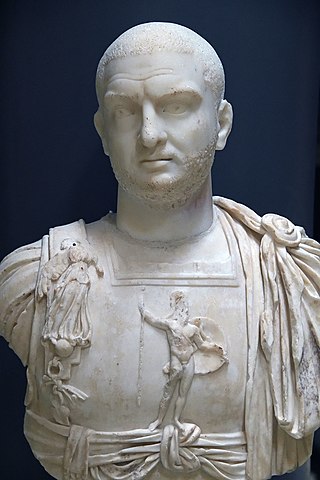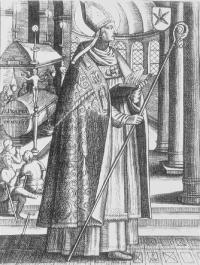
Volusian (French : Volusien) (Latin : Volusianus) was the seventh Bishop of Tours, from 491 to 498. He is venerated as a saint in the Catholic Church.

Volusian (French : Volusien) (Latin : Volusianus) was the seventh Bishop of Tours, from 491 to 498. He is venerated as a saint in the Catholic Church.
Volusian came from a rich and pious senatorial family, and was a close relative of his predecessor Perpetuus, as well as of Ruricius of Limoges. He was deprived of his see by the Visigoths, exiled to Toulouse, and perhaps martyred. [1]
His feast day is January 18. He is the patron saint of Foix.
Pope Sixtus III was the bishop of Rome from 31 July 432 to his death on 18 August 440. His ascension to the papacy is associated with a period of increased construction in the city of Rome. His feast day is celebrated by Catholics on 28 March.

Pope Sylvester I was the bishop of Rome from 31 January 314 until his death. He filled the see of Rome at an important era in the history of the Western Church, yet very little is known of him. The accounts of his pontificate preserved in the seventh- or eighth-century Liber Pontificalis contain little more than a record of the gifts said to have been conferred on the church by Constantine I, although it does say that he was the son of a Roman named Rufinus. His feast is celebrated as Saint Sylvester's Day, on 31 December in Western Christianity, and on 2 January in Eastern Christianity.
Pope Dionysius was the bishop of Rome from 22 July 259 to his death on 26 December 268. His task was to reorganize the Roman church, after the persecutions of Emperor Valerian I and the edict of toleration by his successor Gallienus. He also helped rebuild the churches of Cappadocia, devastated by the marauding Goths.

Gaius Vibius Trebonianus Gallus was Roman emperor from June 251 to August 253, in a joint rule with his son Volusianus.

Foix is a commune, the former capital of the County of Foix. It is the capital of the department of Ariège as it is the seat of the prefecture of that department. Foix is located in the Occitanie region of southwestern France. It is the second least populous French departmental capital, the least populous being Privas. Foix lies south of Toulouse, close to the borders with Spain and Andorra.

Hildebert of Lavardin was a French ecclesiastic, hagiographer and theologian. From 1096–97 he was bishop of Le Mans, then from 1125 until his death archbishop of Tours.

Leodegar of Poitiers was a martyred Burgundian Bishop of Autun. He was the son of Saint Sigrada and the brother of Saint Warinus.
Saint Reticius was a bishop of Autun, the first one known to history, according to the Catholic Encyclopedia. He was a Gallo-Roman, and an ecclesiastical writer, and served as bishop of this see from around 310 to 334 AD.

Gaston IV was the sovereign Viscount of Béarn and the Count of Foix and Bigorre in France from 1436 to 1472. He also held the viscounties of Marsan, Castelbon, Nébouzan, Villemeur and Lautrec and was, by virtue of the county of Foix, co-prince of Andorra. From 1447 he was also Viscount of Narbonne. Through his marriage to Eleonor, heiress of the Kingdom of Navarre, he also held the title of Prince of Navarre.

Perpetuus was the sixth Bishop of Tours, serving from 460 to 490.

Viktor of Xanten was a 4th century martyr and saint recognized by the Roman Catholic Church and the Eastern Orthodox Church. Since the 12th century, his presumed bones have been kept in a shrine, which is embedded in the high altar of the Xanten Cathedral. His feast day is October 10.
Floribert of Liège was a bishop of Liège, and a saint of the Catholic and Orthodox Churches, celebrated on 27 April. He was the son of the French-born Hubert of Liège, also a saint, and succeeded on his death.
Sigo was a Burgundian abbot of the sixth century. He is a saint of the Roman Catholic Church, an Orthodox saint and the reputed founder of the Abbey of Saint-Seine and in the Orthodox Church.

The Diocese of Aire and Dax is a Latin Church ecclesiastical territory or diocese of the Catholic Church in France. It comprises the département of Landes, in the région of Gascony in Aquitaine.

The Diocese of Pamiers, Couserans, and Mirepoix is a Latin Church diocese of the Catholic Church in southern France. The diocese comprises the department of Ariège and is suffragan to the Archdiocese of Toulouse. The diocese of Pamiers is divided into five Deaneries: Pamiers, Foix, Haut-Ariège, Couserans, and Pays-d'Olmes-Mirapoix. The episcopal see is the Cathedral of Saint Antoninus in the city of Pamiers.

José de Calasanz, or in Catalan Calassanç , bon José Vives y Tutó(or, in Catalan, Josep Vives i Tutó); his given name is written in English as Joseph Calasanz), OFMCap, was an influential Spanish Roman Catholic theologian, member of the Capuchin friars and from 19 June 1899 also cardinal. To distinguish him from the saint Giuseppe Calasanzio from whom he took his name, he is known as either José de Calasanz Vives y Tutó or Cardinal Calasanz.

Pierre Batiffol – was a French Catholic priest and prominent theologian, specialising in Church history. He had also a particular interest in the history of dogma.

Jacques de Foix (1463–1508) was a Count of Montfort and "Captal Buch," and the so-called “Infante of Navarre”.

The Church of Saint-Volusien is an abbatial church in Foix, Ariège in southwestern France. It already existed in the 12th century and was re-built and renovated several times.
Florentius is a saint of the Roman Catholic Church and a bishop of Vienne from the late 4th century, dated by his attendance at the Council of Valence in 374.